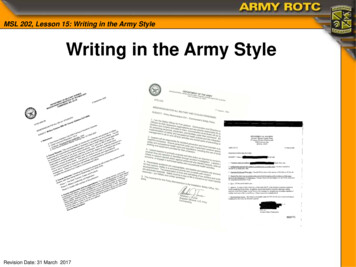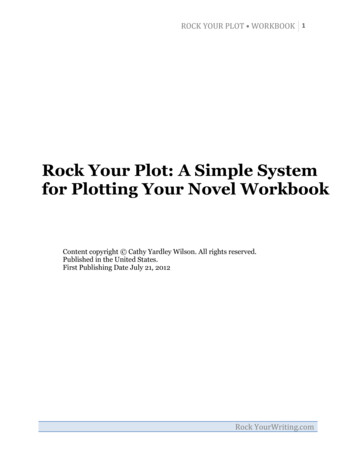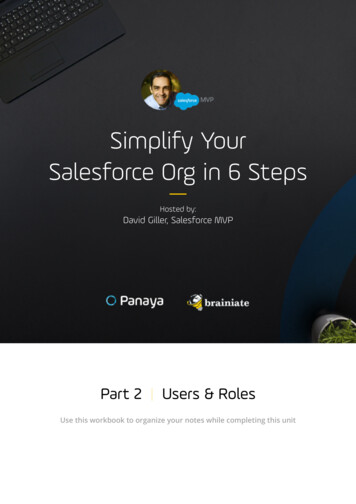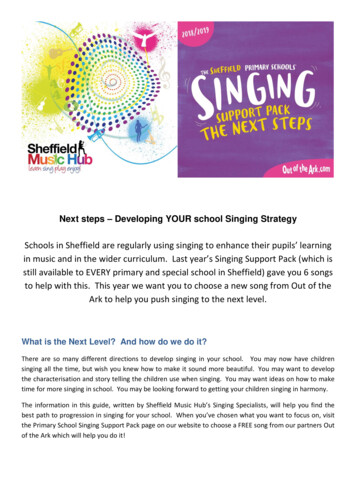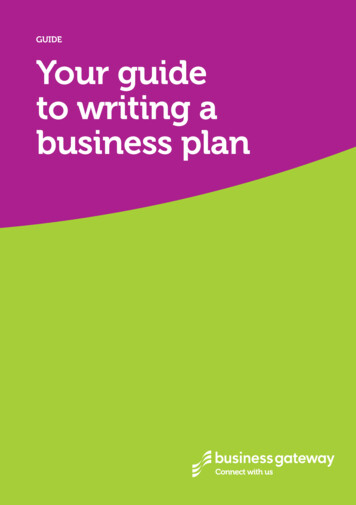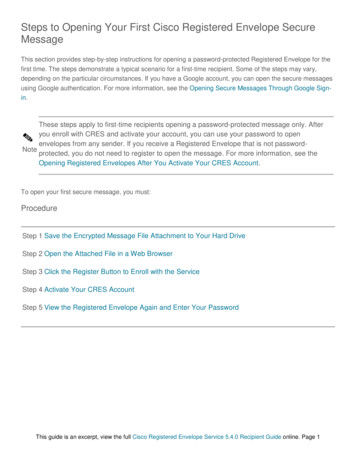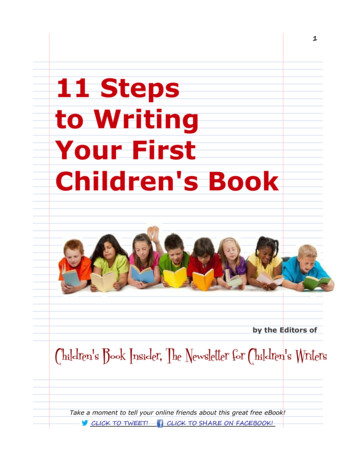
Transcription
111 Stepsto WritingYour FirstChildren's Bookby the Editors ofChildren's Book Insider, The Newsletter for Children's WritersTake a moment to tell your online friends about this great free eBook!CLICK TO TWEET!CLICK TO SHARE ON FACEBOOK!
2Legal DisclaimersTHIS MATERIAL MAY NOT BE COPIED AND DISTRIBUTEDWITHOUT THE EXPRESS WRITTEN PERMISSION OF THEPUBLISHER.Copyright 2012, Children’s Book Insider, LLC all rights reserved. No part of thisbook may be reproduced or utilized in any form or by any means electronic ormechanical, including photocopying, recording or by any information storageand retrieval system, without written permission from the publisher.Children’s Book Insider, LLC901 Columbia RdFort Collins, CO 80525http://www.cbiclubhouse.com/IMPORTANT NOTICE TO READERS: This publication is designed to provideaccurate and authoritative information in regard to the subject matter covered.This information is sold with the understanding that the publisher is notengaged in rendering legal, accounting or any other professional service. Iflegal advice or other expert assistance is required, the service of a competentprofessional should be sought. Therefore, the Author and Publisher assume noresponsibility to any person or persons in connection with the use of thispublication, and this publication is sold with this understanding and none other.Take a moment to tell your online friends about this great free eBook!CLICK TO TWEET!CLICK TO SHARE ON FACEBOOK!
3So, You Wanna Be a Children's Book Writer?Awesome!Writing a children's book is one of the mostrewarding and enriching experiences imaginable.We've been helping ordinary folks just like you becomepublished children's book authors since 1990 and, along theway, we've managed to boil down the entire process into tensteps (plus one bonus step that's maybe the mostimportant.).In this eBook, we'll share those steps with you, and providelinks to great information that will make your journeyenjoyable, easy and fun.We hope you'll be inspired and encouraged by what you'll find.We also hope that you'll make the big step that has liftedmany people from “wannabe” status to being successfulauthors: joining the Fightin' Bookworms of Children's BookInsider!We have a special offer for you later on. Until then, let's startyour journey!PS: If you enjoy the book, please share it with other aspiring writers byusing the Twitter and Facebook links at the bottom of each page. We'dreally appreciate it!Take a moment to tell your online friends about this great free eBook!CLICK TO TWEET!CLICK TO SHARE ON FACEBOOK!
4Step 1: Get the Right MindsetIf you dream of writing for children because you see it as aroute to fame and riches, it's time we had a little talk:That's probably not going to happen.Sure, it might happen -- J.K. Rowling's doing quite nicely,thank you. But the vast majority of children's writers do it forlove, not money. They have a passion for sharing ideas andconnecting with young readers that means more than wealthor recognition.If you have that passion, than all the lonely hours of writingand the occasional rejection letter are just small prices to payfor the opportunity to create something wonderful and(hopefully) lasting.So let's start our journey by looking inward. I'm going to askyou some questions.Take whatever time you need andanswer them honestly. If you've printed this eBook out, writethe answers in the space provided. Otherwise, write youranswers in a journal or other text document. Here goes:Why do you want to write for children?Take a moment to tell your online friends about this great free eBook!CLICK TO TWEET!CLICK TO SHARE ON FACEBOOK!
5What unique viewpoints, experience or wisdom do youhave to offer young readers?How well do you deal with criticism and rejection? Ifthe answer is “not so well”, are you willing to develop athicker skin?Do you regularly read current children's books, or isyour knowledge of the children's book market largelybased on your own childhood experience, or from beinga parent years ago?Take a moment to tell your online friends about this great free eBook!CLICK TO TWEET!CLICK TO SHARE ON FACEBOOK!
6Are you willing to learn, and invest in yourself tobecome a better writer?This isn't a quiz, and there are no right or wrong answers. Butthere are some things you need to understand before weproceed:This will take time. Anyone who tells you that you canknock out a children's book, send it off to a paying publisherand see your book on the shelves in a couple of months isn'tbeing truthful. You'll have peaks and valleys on your journeythat will require patience and perseverance.It's not easy. Contrary to what you may have been told,writing children's books is not easier than writing for adults.Yes, kids' books are shorter, but that just makes things morechallenging. The author Mem Fox put it best: “Writing apicture book is like writing 'War and Peace' in haiku.”Craft is Everything. There are two kinds of writers – thosewho say “I've written my story. Where do I send it?' andthose who say “I've written my first draft. How do I make theplot smoother, the dialogue better and the characters morebelievable?” Can you guess which author invariably succeeds?Writing is an art. Mastering it offers the same challenges andrewards of mastering the violin, or skiing or painting.Takeyour time, sharpen your skill, learn to love the journey.Publishing will always be out there but, if you really want toTake a moment to tell your online friends about this great free eBook!CLICK TO TWEET!CLICK TO SHARE ON FACEBOOK!
7make it , worry more about being a skilled writer. The restwill take care of itself.Don't Preach. You have a message you want to impart tokids? That's fine. But chill. No one, young or old, wants toread a story that practically bangs them over the head with a“moral”.Skillful writers know how to subtly incorporate their messageinto a compelling read. Until you master your craft, stick tomaking kids laugh, or gasp with fear or swoon with romancebefore you try to tell them something “important”.Relax. For all its challenges, starting a children's writingcareer is a truly wonderful adventure. You'll meet amazingfolks along the way, learn more about yourself than you everimagined and, ultimately, make your mark on the life of ayoung reader.That's pretty cool. Just remember to havepatience, stay the course, invest in learning to sharpen yourskills and keep on writing no matter what. The payoff iscertain to be worth it!Now go back and look at the answers you provided to thequestions I posed. Do they fit with what we've just covered?Are there some areas that will require a bit of attitudeadjustment?Let all of this sink in a bit and revisit thosequestions later. You might just find that you're very muchprepared for the journey ahead.Before we leave Step 1, here are some links that willreally help:VIDEO: Think Like a Writer, Not an Author5 Ways for Writers to Blast Through Self-DoubtTake a moment to tell your online friends about this great free eBook!CLICK TO TWEET!CLICK TO SHARE ON FACEBOOK!
8Step 2: Choose Your Age GroupThe world of children's literature is divided along age lines.Become familiar with the standard categories and read fromeach of them. Before long you'll find yourself gravitatingtoward one or two of these. That's how you'll know whichage group you're best suited for.Here are the categories, along with some classic books tocheck out:* Picture books — In its broadest definition, a picture bookis a book in which the illustrations play a significant role intelling the story. Under this umbrella are several types ofbooks:1. Baby Books – For infants and young toddlers, these booksare generally lullabies, nursery rhymes, fingerplays, orwordless books. The length and format varies with thecontent.2. Toddler books – Very simple stories for ages 1-3 (under300 words) familiar to a child's everyday life, or concept books(teaching colors, numbers, shapes, etc.) Books are short (12pages is average) and the format can be board books (sturdypaper-over board construction), pop-ups, lift-the flaps ornovelty books (books that make sounds, have differenttextures, etc.) See the "Max" series of board books byRosemary Wells (Dial).3. Picture books – Traditionally, picture books (also called"picture story books") are 32-page books for ages 4-8 (thisage may vary slightly by publisher). Manuscripts are up to1500 words, with 1000 words being the average length.Take a moment to tell your online friends about this great free eBook!CLICK TO TWEET!CLICK TO SHARE ON FACEBOOK!
9Plots are simple (no sub-plots or complicated twists) withone main character who embodies the child's emotions,concerns and viewpoint. The illustrations (on every page orevery other page) play as great a role as the text in tellingthe story. Occasionally a picture book will exceed 1500words; this is usually geared toward the upper end of theage spectrum. Picture books cover a wide range of topicsand styles. The list of Caldecott Medal winners, availablehere, is a good place to start your research. Nonfiction in thepicture book format can go up to age 10, 48 pages in length,or up to about 2000 words of text.4. Early picture books – A term for picture books gearedtoward the lower end of the 4-8 age range. These stories aresimple and contain under 1000 words. Many early picturebooks have been reprinted in the board book format, thuswidening the audience. The Very Hungry Caterpillar by EricCarle (Philomel) is an example.* Easy readers – Also called "easy-to-read", these booksare for children just starting to read on their own (age 6-8).They have color illustrations on every page like a picturebook, but the format is more "grown-up" — smaller trimsize, sometimes broken into short chapters. The lengthvaries greatly by publisher; the books can be 32-64 pageslong, with 200-1500 words of text, occasionally going up to2000 words. The stories are told mainly through action anddialogue, in grammatically simple sentences (one idea persentence). Books average 2-5 sentences per page. See the"Amelia Bedelia" books by Peggy Parish or other "I CanRead" books published by Harper Trophy.Take a moment to tell your online friends about this great free eBook!CLICK TO TWEET!CLICK TO SHARE ON FACEBOOK!
10* Transition books — Sometimes called "early chapterbooks" for ages 6-9, they bridge the gap between easyreaders and chapter books. Written like easy readers in style,transition books are longer (manuscripts are about 30 pageslong, broken into 2-3 page chapters), books have a smallertrim size with black-and-white illustrations every few pages.See "The Kids of the Polk Street School" series by PatriciaReilly Giff (Dell) or the "Stepping Stone Books" published byRandom House.* Chapter books — For ages 7-10, these books are 45-60manuscript pages long, broken into 3-4 page chapters. Storiesare meatier than transition books, though still contain a lot ofaction. The sentences can be a bit more complex, butparagraphs are still short (2-4 sentences is average). Chaptersoften end in the middle of a scene to keep the reader turningthe pages. Look at the "Herbie Jones" books by Suzy Kline(Puffin) and the "Ramona" books by Beverly Cleary (Morrow).* Middle grade — This is the golden age of reading for manychildren, ages 8-12. Manuscripts suddenly get longer (100150 pages), stories more complex (sub-plots involvingsecondary characters are woven through the story) andthemes more sophisticated. Kids get hooked on characters atthis age, which explains the popularity of series with 20 ormore books involving the same cast. Fiction genres range fromcontemporary to historical to science fiction/fantasy;nonfiction includes biographies, science, history andTake a moment to tell your online friends about this great free eBook!CLICK TO TWEET!CLICK TO SHARE ON FACEBOOK!
11multicultural topics. Check out some middle grade novels fromthe list of Newbery Medal winners to get you started.* Young adult – For ages 12 and up, these manuscripts are130 to about 200 pages long. Plots can be complex withseveral major characters, though one character shouldemerge as the focus of the book. Themes should be relevantto the problems and struggles of today's teenagers,regardless of the genre. The Outsiders by S.E. Hinton definedyoung adult when it was first published in 1967; theNewbery Medal award list also contains many worthy titles. Anewer age category (10-14) is emerging, especially withyoung adult nonfiction. These books are slightly shorter thanthe 12 and up category, and topics (both fiction andnonfiction) are appropriate for children who have outgrownmiddle grade but aren't yet ready for the themes (fiction) orwho aren't studying the subjects (nonfiction) of high schoolreaders.Before you move on, check out this short video:How Do I Determine the Proper Age Group For My Manuscript?Take a moment to tell your online friends about this great free eBook!CLICK TO TWEET!CLICK TO SHARE ON FACEBOOK!
12Step 3: Develop Your IdeaLet's begin with a simple test to determine what, exactly, youfeel passionate about. Once we have that, you can startpolishing a story idea.You walk into a bookstore with a large magazine selection.Where do you go first?Crafts magazines? Photography? Sports? Cooking?Your answer (unless you head right to Playboy or High Times)has given you a tremendous starting point for your first story.Start with your passion and writing will seem much, mucheasier!Combine this passion with what we've just learned about agegroups and you might start seeing a clear picture of your firstmanuscript. A middle grade story about a youngphotographer? A chapter book about a boy who dreams ofbeing a famous chef? A picture book about a little girl whoidolizes race car drivers and wants to be one? It's all up toyou!So, now that you’ve explored your interests and discoveredthat you’re drawn to picture book biographies, or middlegrade novels, or silly easy readers, you’ve probably got someideas itching to be developed. So let’s see if they’re reallyready to be turned into books.First, sum up your idea. Write the general concept for yourstory or nonfiction book in one to three sentences. You’re notgoing to get every nuanced relationship or plot point intothose three sentences, but you should be able to convey theessence of what makes your idea unique. You may not knowTake a moment to tell your online friends about this great free eBook!CLICK TO TWEET!CLICK TO SHARE ON FACEBOOK!
13much about your idea at this point, so write what you know.Maybe you know your main character and his/her problem,and have some ideas about how that problem might besolved.Perhaps you read an article about new research being done onhow dolphins communicate, and think the topic would make agreat picture book.Sum up your idea and a few specific key points that give youridea some shape. “Dolphins” isn’t specific enough. “Howdolphins communicate, and new research that suggestsdolphins actually have a meaningful language” is a startingpoint for a book. “Jeremy gets a new baby brother,” isn’tanything special. “Jeremy tries to sell his new baby brother atthe neighborhood garage sale” is the basis for a plot.If you’ve been reading books for the age group you’reinterested in writing for, now you can compare your idea topublished books and judge if it’s right for youraudience. Does your picture book idea lend itself well tomany different action scenes and illustrations? Or does it relyheavily on dialogue and internal character development that isbest expressed through thoughts and emotions? If the latterapplies to your idea, it’s better suited to a novel.Since it’s still just an idea (and not the whole first draft ofyour manuscript), you shouldn’t be too invested in keeping itexactly as it first came to you. In most cases, published booksare the result of ideas that have evolved past the initial sparkof inspiration. So now’s the time to brainstorm and playwith the concept. Ask, “What if?” What if the main characterwere a boy instead of a girl? What if I used my idea as aspringboard for a more complex story for young adults? Whatif I changed the time period from the present to 1975?Take a moment to tell your online friends about this great free eBook!CLICK TO TWEET!CLICK TO SHARE ON FACEBOOK!
14What if I took my serious topic of global warming and addedsome humorous sidebars? Or, what if I created a childcharacter to “host” the book, who lives in the future aftermany of the climate changes have taken place? What if Iwrote the entire book as free verse? What if my picture booklooked like different pages from a character’s web site?Think big. Get weird. Reach for the most outrageousconcept you can, then dial it back until it makes sense. Theone thing that will keep your idea from ever gettingpublished is if it’s ordinary. A predictable, safe, run-of-themill book simply won’t justify the publisher’s substantialfinancial investment to bring it to print. Your book doesn’thave to be shocking, or violent, or disturbing, but it doeshave to be fresh, interesting and surprising. It has to besomething the editor’s never seen before. And chances are,your first idea won’t fit these criteria.Study authors who have charted new ground with theirbooks. Look at Pirates by David L. Harrison, illustrated byDan Burr (nonfiction picture book for ages 8-12, written as acollection of poems); ttyl by Lauren Myracle (young adultstory of three high school girls written as Instant Messages);Lincoln Shot: A President’s Life Remembered by BarryDenenberg, illustrated by Christopher Bing (written as acommemorative edition of The National News one year afterLincoln’s death, the entire book looks like a 19th-centurynewspaper); or Dav Pilkey’s Captain Underpants chapterbook series (each book a combination of story, comic strip,and Flip-O-Rama). All these books embodied themes andideas that had been touched on before, but packaged in anew, exciting way.Now, watch this:Laura Backes on Developing Stories for Different Age GroupsTake a moment to tell your online friends about this great free eBook!CLICK TO TWEET!CLICK TO SHARE ON FACEBOOK!
15Step 4: Write Your First DraftOver the past 23 years, we've written enough on the subjectof writing craft to fill a library or two. Any attempt to distillthat into a few paragraphs would be a major disservice. Sohere's where we have to make a pitch:Join the Fightin' Bookworms and we'll teach youeverything you need to know.Plot, dialogue, pacing, point of view, character development.It's not brain surgery, but it will take some time and attention.So seriously, spend what you would each month on a lightsnack and you'll have it all at your fingertips. Check us out athttp://cbiclubhouse.comUntil then, here are a few pieces of writing instruction to getyou started:Writing Picture Books - How to Get StartedWrite for Success: 7 Tips For Children's Book WritersWriting Tips: 4 Rules Beginning Children's Book WritersShould Never BreakTake a moment to tell your online friends about this great free eBook!CLICK TO TWEET!CLICK TO SHARE ON FACEBOOK!
16Step 5: Start RevisingThere's a reason your manuscript, in its current state, iscalled a “First Draft”. It's because there's a second, thirdand fourth draft still to come (at least).I don't care how great you think your first draft is, it can getbetter. And it must get better. So now's the time to take yourego out of the equation and look hard at what you've written.Here's a cheat sheet to help you:1.Go to the library and ask for the librarian's opinion aboutthe best recent books in your age range. Read them. Thenread your manuscript. How do they differ? Where does yourstory bog down while the other books soar? If you're honestwith yourself, you'll soon see that you have work to do. Ifyou're attentive, you'll also know where you have work to do.2.Read your manuscript multiple times, each time lookingat only one specific thing:* Is the plot interesting and realistic?* Are the characters real, or do they sound stagey and stiff?* Does your dialogue sound like two real people who actuallyhaving a discussion?* Are you describing too much, rather than letting the detailsunfold naturally? (This is also known by the old axiom “show,don't tell”.)* Does your idea still hold up? If not, change it to make itmore original/marketable/interesting.)Starting to discover your flaws?manuscript!Great!Now rewrite thatTake a moment to tell your online friends about this great free eBook!CLICK TO TWEET!CLICK TO SHARE ON FACEBOOK!
17Step 6: Get FeedbackOK, here comes the scary part: It's time to let someone elselook at your manuscript!But not just anyone. What you need here isn't cheerleadingfrom loved ones. The most important feedback you can get isactual constructive criticism from people who know children'sliterature.There are a few places to look for honest feedback:Your local children's librarian. She's pretty busy but, ifyou develop a relationship and ask nicely, your friendly locallibrarian may be willing to take a gander at your story andoffer some thoughts.Local writer's groups. Check the bulletin board at yourlibrary and poke around Craigslist to see if any active writinggroups are accepting new members in your area. Meetup.comis worth a look, too.Online critique partners. At the CBI Clubhouse, Fightin'Bookworms can connect via our Critique Exchange and swapcritiques with one another. It's a great way to make newwriting friends, get feedback and sharpen your own critiquingskills.Professional Critique Services: Spending a bit of moneyand having a professional editor review your critique can be agreat investment. This is the ultimate in objective, expertopinions. Here's some info about a service we onalizedcritique/Take a moment to tell your online friends about this great free eBook!CLICK TO TWEET!CLICK TO SHARE ON FACEBOOK!
18Step 7: Revise Again!Take the feedback you received in Step 6 and ask yourselfthe same questions you posed in Step 5.Chances are, you've got more work to do! And that's a goodthing – every time you revise, you make your manuscriptstronger and more publisher.Get cracking!Take a moment to tell your online friends about this great free eBook!CLICK TO TWEET!CLICK TO SHARE ON FACEBOOK!
19Step 8: Choose Your Path to PublicationWe’ve been working with aspiring children’s book writers for23 years. And, for the majority of that time, our response tothe question “How do I get published” has been the same:Craft a terrific manuscript, research publishers, assemble astrong submissions package, send it off .and wait.If you’re one of the fortunate ones, your wait will be rewardedwith a contract offer. If you’re like most writers, the cycle willbe completed by another rejection letter. Not the mostfulfilling process, but it was the only process that worked.Placing your fortunes in the hands of an unknown, unseeneditor is such an ingrained part of being a writer that it’s hardto imagine an alternative reality. And yet, an alternativereality is precisely what’s been created. And each of us arecitizens of this brave new world.Writers can, if they are so inclined, completely sidestep thetraditional publishing structure and take on a moreentrepreneurial role. Thanks to eBooks, apps and print ondemand, the ability to create, promote and sell one’s writingare now within the reach – and budget – of almost everywriter. And, for the first time since Gutenberg, the verydefinition of “book” is being rewritten.For many in the writing community, the reaction to all of thishas been panic. That’s easy to understand. Unlike the world ofcomputers and technology, publishing has always evolved at arather glacial pace. But now, the future of the written world istied inextricably to the ones and zeros of the digitalmarketplace, and — just like that – writers, librarians,booksellers and publishers find themselves part of an industryTake a moment to tell your online friends about this great free eBook!CLICK TO TWEET!CLICK TO SHARE ON FACEBOOK!
20that moves at light speed. After centuries crawling at a snail’space, the new velocity is startling. And scary.But here’s the good news: the dust is settling, and the roadahead is finally becoming clearer. And, we believe, it’s a roadthat can take writers to some very exciting places.In order to fully appreciate this new path, each of us mustfirst take a giant step back, and remember somethingfundamental:We’re storytellers. And, for thousands of years, storytellershave known one vital fact — it’s about the story, not themedium.Whether on cave walls, around a roaring fire, on papyrus,glossy paper or in the glow of an eReader, a story is still astory. Failing to understand every detail of how books gottypeset, printed, bound and shipped never prevented anyonefrom writing a bestseller. Nor should your current level ofknowledge regarding digital technology be in any way inimpediment to thriving in the decades ahead.Just tell your story. You’ll figure out the rest when you needto. Until then, know this:Today, For the First Time, The Author Has The Powerto Choose His or Her Path to PublicationChoice power. And you now have choices.You can still go the traditional route, submitting yourmanuscripts to publishers. It’s as valid a way of reaching themarket as it ever was. But now you can choose to opt out ofTake a moment to tell your online friends about this great free eBook!CLICK TO TWEET!CLICK TO SHARE ON FACEBOOK!
21that model. Self-publish, create eBooks for the Nook andKindle, build an App for the iPhone or Android. It’s allpossible, it’s all eminently doable and it’s all now acompletely legitimate means of publishing your work andreaching millions. No more waiting around for someone else’sarbitrary decision. You have control, so use it.And get your ego out of the way. Sure, it’s a thrill to see yourbook in a bookstore. And yeah, perhaps seeing it in online ineBook form isn’t quite as compelling.But it’s not about you and your ideal of what being an“author” is. It’s about your reader. And if a young person ismoved by something you wrote, it matters little whether it’son a printed page, an eReader or even a smart phone. Reachyour readers how they want to be reached, and the rest willsort itself out.So, why are we telling you all of this?Because we want to change your definition of what itmeans to “be published.”Write apps. Write eBooks. Create videos. And don't worry ifyou don't yet understand these technologies.We do. And we'll teach you.Take a moment to tell your online friends about this great free eBook!CLICK TO TWEET!CLICK TO SHARE ON FACEBOOK!
22Step 9: Research the Market!If you've decided to take a shot at creating apps or eBooks,your next step will be to learn the lay of the digitallandscape. The hows and whys of building and marketingyour electronic creation. If you're at that stage, check outthese sections of the CBI Clubhouse to find what you hto-publication/app-publishing/But perhaps you're saying “eBooks and apps are great. But Istill want to get a book published traditionally and see it inmy local bookstore.”We hear you. Traditional publishing isn't going anywhere andyep, there is something to be said for receiving a niceadvance check and maybe royalties. And then there's thethrill of seeing your name on a bookstore shelf alongside thegreats.So let's go on to the next step – researching the publishingmarket and finding the right potential publishers for yourmanuscript.We've made that part easy.out exactly how to do it:Here's a quick video that e a moment to tell your online friends about this great free eBook!CLICK TO TWEET!CLICK TO SHARE ON FACEBOOK!
23Step 10: Submit Your Manuscript!You've polished your manuscript, researched appropriatepublishers and studied their submission guidelines. Nowyou're finally going to send your manuscript out into theworld to be read by editors.Publishers will specify on their guidelines exactly what theywant to see from authors. The submission packets usually fallinto the categories below:Cover letter with the entire manuscript:When sending the entire manuscript, you only need to includea brief cover letter. This letter contains 3-4 short paragraphs:One with the title of the book, the word count, the age of theaudience and the genre (humorous picture book for ages 3-6;historical middle grade mystery). The second paragraph givesa 1-4 sentence synopsis of the book, just enough informationso the editor knows if the subject will appeal to her, or if sheshould pass the manuscript on to a colleague. Then list anypublishing credits, awards and memberships in writingorganizations (if you're a beginner, just leave this paragraphout). Finally, thank the editor for her time, and state thatyou've enclosed a SASE for her reply (see below).Query letter:A query is a one-page letter that describes the manuscriptwith enough detail so the editor knows if she wants to readthe whole work. Many editors prefer to receive queries for theinitial submission. A query letter has a similar format to acover letter but the synopsis can be more detailed, andshould be written in the tone of the manuscript (humorous,Take a moment to tell your online friends about this great free eBook!CLICK TO TWEET!CLICK TO SHARE ON FACEBOOK!
24scary, rhythmic, etc.) Think of the synopsis as a pitch for yourbook, something that might appear on the jacket flap.Query letterchapters:withoutline/synopsisandsampleFor works longer than picture books and easy readers, editorsmay request that the query be accompanied by more detailedinformation. A separate synopsis can be several paragraphsl
Nov 11, 2012 · novelty books (books that make sounds, have different textures, etc.) See the "Max" series of board books by Rosemary Wells (Dial). 3. Picture books – Traditionally, picture books (also called "picture story books") are 32-page books for ages 4-8 (this a
